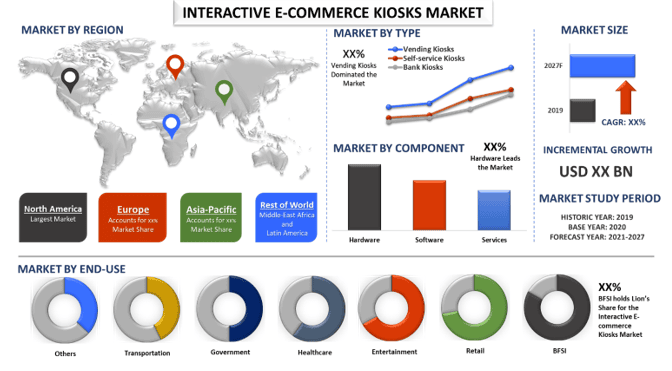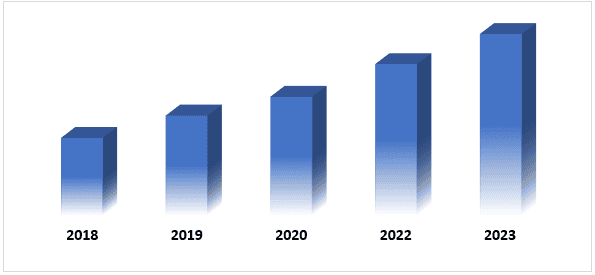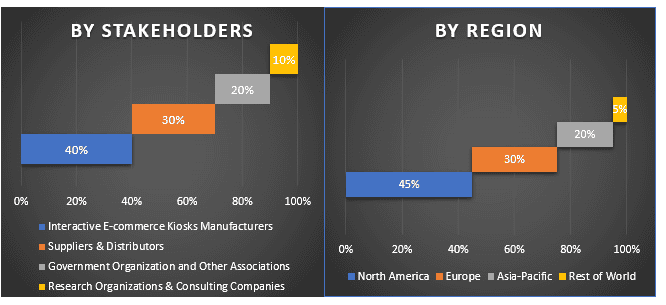- Home
- About Us
- Industry
- Services
- Reading
- Contact Us
Interactive E-commerce Kiosks Market: Current Analysis and Forecast (2021-2027)
Emphasis on Type (Bank Kiosks, Self-Service Kiosks, Vending Kiosks); Component (Hardware, Software, Services); End-Use (Retail, Entertainment, Healthcare, BFSI, Government, Transportation, Others); Region/Country

Global Interactive E-commerce Kiosks Market was valued at US$ 26.2 billion in 2020 and is anticipated to reach US$ 36.22 billion by 2027 displaying an elevated CAGR of 4.8% over the forecast period (2021-2027). A self-service device deployed at various public utilities and aids the users to interact with digital content and information through a user-friendly interface is known as interactive kiosks. These are used for retail sales, billing, wayfinding, information sharing, and tourism, etc.
With the growing advancement in technology in all the sectors and the demand for personalized and efficient services, many industry players are shifting the landscape by engaging customers with this interactive technology which in turn is enhancing the customer experience. For instance, an innovative concept was launched by a restaurant in China named “Yum China Holdings”, the concept to deploy a set of free-standing ordering kiosks in their store including features such as facial recognition and payments into the screens. Furthermore, the interactive kiosks are also gaining traction among the airport authorities owing to the need to reduce long check-in and check-out queues. Thereby, boosting the market growth globally.
The growth of the interactive e-commerce kiosks market can be attributed to the spur in smart city and smart infrastructure deployment and increase in initiatives by various private and government authorities to install kiosks in public areas. For instance, in 2021, Houston City Council approved a proposal for the installation of nearly 125 digital kiosks in the areas of Houston such as downtown and the Galleria. These 8-foot-tall kiosks in these areas will provide information regarding various local sights and attractions along with advertisements. In addition to this, the increase in the number of consumers shifting towards the adoption of self-service systems is also adding pace to the interactive e-commerce market globally.

Current and Projected Technology Spending on Smart City Initiatives Globally, 2018-2023 (in USD billion)
NCR Corporation, Diebold Nixdorf AG, KIOSK Information Systems, ZEBRA Technologies Corporation, Emboss Ltd., Meridian Kiosks LLC, Advanced Kiosks, Redyref Interactive Kiosks, Source technologies, SlabbKiosks are some of the prominent players operating in the interactive e-commerce kiosks market. Several M&As along with partnerships have been undertaken by these players to facilitate customers with new and innovative kiosks.
Insights Presented in the Report
“Amongst Type, Vending kiosks segment holds the major share”
Based on type, the market is fragmented into bank kiosks, self-service kiosks, and vending kiosks. The vending kiosks generated the highest revenue in 2020 and is expected to grow remarkably during the forecast period to reach lead the market by 2027F owing to the increase in retail stores and quick-service restaurants & hotels as this would enhance the shopping experience for customers. For instance, in the United States, Subway, a sandwich chain was the leading quick-service restaurant chain with 23,801 locations across the country in 2019.
“Amongst Component, Hardware segment holds the major share”
Based on the component, the market is fragmented into hardware, software, and services. The hardware segment is expected to garner a major market share in 2020 and grow at a considerable CAGR during the forecast period(2021-2027). This segment includes displays, printers, scanners, sensors, among others. The growth of this segment is attributed to the growing technological advancement and frequent launches of advanced kiosks. For instance, in July 2021, imageHOLDERS have launched its first touchless self-service kiosks which is powered by Ultraleap hand tracking camera and Ultraleap TouchFree software to capture the movement of hands and fingers so they can interact naturally with the on-screen content. Owing to this, there has been an increase in demand for various kiosks hardware as more and more industry players are focusing on launching innovative advanced kiosks.
“Amongst End-Use, BFSI segment holds the major share”
Based on the end-use, the market is fragmented into retail, entertainment, healthcare, BFSI, government, transportation, and others. The BFSI segment dominated the market and is expected to grow at skyrocketed CAGR during the forecast period. The growth of this segment is attributed to the growing number of people opting for self-service kiosks as they allow the consumers to undertake banking transactions at their own convenience without visiting the bank branch. However, the retail segment is also expected to grow significantly in the upcoming years.
“North America represents one of the largest markets of interactive e-commerce kiosks market”
For a better understanding of the market dynamics of the interactive e-commerce kiosks market, a detailed analysis was conducted for different regions across the globe including North America (the U.S, Canada, and the Rest of North America), Europe (Germany, France, Spain, United Kingdom, Italy, and Rest of Europe), Asia-Pacific (China, Japan, India, Australia, and Rest of APAC), Rest of World has been conducted. North America dominated the market and generated revenue of US$ XX million in 2020 owing to the increasing adoption of self-service kiosks in the various food chain and public utilities including airports and seaports. However, Asia-Pacific is also expected to grow at a significant CAGR during the projected timeframe.
Reasons to buy this report:
- The study includes market sizing and forecasting analysis validated by authenticated key industry experts
- The report presents a quick review of overall industry performance at one glance
- The report covers an in-depth analysis of prominent industry peers with a primary focus on key business financials, product portfolio, expansion strategies, and recent developments
- Detailed examination of drivers, restraints, key trends, and opportunities prevailing in the industry
- The study comprehensively covers the market across different segments
- Deep dive regional level analysis of the industry
Customization Options:
The global interactive e-commerce kiosks market can further be customized as per the requirement or any other market segment. Besides this, UMI understands that you may have your own business needs, hence feel free to connect with us to get a report that completely suits your requirements.
Table of Content
Analyzing the historical market, estimation of the current market, and forecasting the future market of the Global interactive e-commerce kiosks market were the three major steps undertaken to create and analyze the adoption of interactive e-commerce kiosks in major regions globally. Exhaustive secondary research was conducted to collect the historical market numbers and estimate the current market size. Secondly, to validate these insights, numerous findings and assumptions were taken into consideration. Moreover, exhaustive primary interviews were also conducted, with industry experts across the value chain of the global interactive e-commerce kiosks market. Post assumption and validation of market numbers through primary interviews, we employed a top-down/bottom-up approach to forecasting the complete market size. Thereafter, market breakdown and data triangulation methods were adopted to estimate and analyze the market size of segments and sub-segments the industry pertains to. Detailed methodology is explained below:
Analysis of Historical Market Size
Step 1: In-Depth Study of Secondary Sources:
Detail secondary study was conducted to obtain the historical market size of the interactive e-commerce kiosks through company internal sources such as annual report & financial statements, performance presentations, press releases, etc., and external sources including journals, news & articles, government publications, competitor publications, sector reports, third-party database, and other credible publications.
Step 2: Market Segmentation:
After obtaining the historical market size of the interactive e-commerce kiosks market, we conducted a detailed secondary analysis to gather historical market insights and share for different segments & sub-segments for major regions. Major segments included in the report as type, component, and end-use. Further country-level analyses were conducted to evaluate the overall adoption of interactive e-commerce kiosks across the globe.
Step 3: Factor Analysis:
After acquiring the historical market size of different segments and sub-segments, we conducted a detailed factor analysis to estimate the current market size of the interactive e-commerce kiosks. Further, we conducted factor analysis using dependent and independent variables such as growing adoption of interactive e-commerce kiosks in various sectors. A thorough analysis was conducted for demand and supply-side scenarios considering top partnerships, merger and acquisition, business expansion, and product launches in the interactive e-commerce kiosks sector across the globe.
Current Market Size Estimate & Forecast
Current Market Sizing: Based on actionable insights from the above 3 steps, we arrived at the current market size, key players in the interactive e-commerce kiosks market, and market shares of the segments. All the required percentage shares split, and market breakdowns were determined using the above-mentioned secondary approach and were verified through primary interviews.
Estimation & Forecasting: For market estimation and forecast, weights were assigned to different factors including drivers & trends, restraints, and opportunities available for the stakeholders. After analyzing these factors, relevant forecasting techniques i.e., top-down/bottom-up approach was applied to arrive at the market forecast about 2027 for different segments and subsegments across the major markets globally. The research methodology adopted to estimate the market size encompasses:
- The industry’s market size, in terms of value (US$) and the adoption rate of interactive e-commerce kiosks across the major markets domestically
- All percentage shares, splits, and breakdowns of market segments and sub-segments
- Key players in the interactive e-commerce kiosks market in terms of products offered. Also, the growth strategies adopted by these players to compete in the fast-growing market
Market Size and Share Validation
Primary Research: In-depth interviews were conducted with the Key Opinion Leaders (KOLs) including Top Level Executives (CXO/VPs, Sales Head, Marketing Head, Operational Head, and Regional Head, Country Head, etc.) across major regions. Primary research findings were then summarized, and statistical analysis was performed to prove the stated hypothesis. Inputs from primary research were consolidated with secondary findings, hence turning information into actionable insights.
Split of Primary Participants in Different Regions

Market Engineering
Data triangulation technique was employed to complete the overall market estimation and to arrive at precise statistical numbers of each segment and sub-segment of the interactive e-commerce kiosks market. Data was split into several segments & sub-segments post studying various parameters and trends in the areas of type, components and end-use of the interactive e-commerce kiosks market.
The main objective of the Interactive E-commerce Kiosks Market Study
The current & future market trends of interactive e-commerce kiosks were pinpointed in the study. Investors can gain strategic insights to base their discretion for investments from the qualitative and quantitative analysis performed in the study. Current and future market trends were determined the overall attractiveness of the market at a regional level, providing a platform for the industrial participant to exploit the untapped market to benefit as a first-mover advantage. Other quantitative goals of the studies include:
- Analyze the current and forecast market size of Interactive e-commerce kiosks in terms of value (US$). Also, analyze the current and forecast market size of different segments and sub-segments
- Segments in the study include areas of types, components and end-use
- Define and analysis of the regulatory framework for the interactive e-commerce kiosks industry
- Analyze the value chain involved with the presence of various intermediaries, along with analyzing customer and competitor behaviors of the industry
- Analyze the current and forecast market size of the interactive e-commerce kiosks market for the major region
- Major regions studied in the report include North America, Europe, Asia-Pacific and Rest of the world
- Company profiles of the interactive e-commerce kiosks market and the growth strategies adopted by the market players to sustain in the fast-growing market
Deep dive regional level analysis of the industry
Analysis of Historical Market Size
Step 1: In-Depth Study of Secondary Sources:
Detail secondary study was conducted to obtain the historical market size of the hydrogen generator market through company internal sources such as annual report & financial statements, performance presentations, press releases, etc., and external sources including journals, news & articles, government publications, competitor publications, sector reports, third-party database, and other credible publications.
Step 2: Market Segmentation:
After obtaining the historical market size of the hydrogen generator market, we conducted a detailed secondary analysis to gather current market insights and share for different segments & sub-segments for major regions. Major segments included in the report are by product type, application, capacity, and process. Further regional and country-level analyses were conducted to evaluate the overall adoption of the hydrogen generator globally.
Step 3: Factor Analysis:
After acquiring the historical market size of different segments and sub-segments, we conducted a detailed factor analysis to estimate the current market size of hydrogen generator. Further, we conducted factor analysis using dependent and independent variables such as growing industrial sector, growing demand for hydrogen due to rising environmental concerns among population etc. A thorough analysis was conducted for demand and supply-side scenario considering top partnerships, merger and acquisition, business expansion, and product launches in the hydrogen generator industry.
Current Market Size Estimate & Forecast
Current Market Sizing: Based on actionable insights from the above 3 steps, we arrived at the current market size, key players in the global hydrogen generator market, and market shares of each segment. All the required percentage shares split, and market breakdowns were determined using the above-mentioned secondary approach and were verified through primary interviews.
Estimation & Forecasting: For market estimation and forecast, weights were assigned to different factors including drivers & trends, restraints, and opportunities available for the stakeholders. After analyzing these factors, relevant forecasting techniques i.e., bottom-up approach was applied to arrive at the market forecast to 2027 for different segments and sub-segments across the major regions globally. The research methodology adopted to estimate the market size encompasses:
- The industry’s market size, in terms of value (US$) and the adoption rate of hydrogen generator across the major markets
- All percentage shares, splits, and breakdowns of market segments and sub-segments
- Key players in the hydrogen generator market in terms of services offered. Also, the growth strategies adopted by these players to compete in the fast-growing market.
Market Size and Share Validation
Primary Research: In-depth interviews were conducted with the Key Opinion Leaders (KOLs) including Top Level Executives (CXO/VPs, Sales Head, Marketing Head, Operational Head, and Regional Head, Country Head, etc.) across major regions. Primary research findings were then summarized, and statistical analysis was performed to prove the stated hypothesis. Inputs from primary research were consolidated with secondary findings, hence turning information into actionable insights.
Split of Primary Participants in Different Regions

Market Engineering
Data triangulation technique was employed to complete the overall market estimation and to arrive at precise statistical numbers of each segment and sub-segment of the global hydrogen generator market. Data was split into several segments & sub-segments post studying various parameters and trends in the areas of product type, application, capacity and process.
The main objective of the Hydrogen Generator Market Study
The current & future market trends of global hydrogen generator were pinpointed in the study. Investors can gain strategic insights to base their discretion for investments from the qualitative and quantitative analysis performed in the study. Current and future market trends would determine the overall attractiveness of the market at a country level, providing a platform for the industrial participant to exploit the untapped market to benefit as a first-mover advantage. Other quantitative goals of the studies include:
- Analyze the current and forecast market size of hydrogen generator in terms of value (US$). Also, analyze the current and forecast market size of different segments and sub-segments
- Segments in the study include areas of product type, application, capacity and process
- Defined analysis of the regulatory framework for the hydrogen generator industry
- Analyze the value chain involved with the presence of various intermediaries, along with analyzing customer and competitor behaviors of the industry
- Analyze the current and forecast market size of the hydrogen generator for the major countries
- Major regions/countries analyzed in the report includes North America (US, Canada, Rest of North America), Europe (Germany, UK, France, Spain, Rest of Europe), Asia-Pacific (China, Japan, India, Australia, Rest of Asia-Pacific), and Rest of World.
- Company profiles of the hydrogen generator market players and the growth strategies adopted by them to sustain in the fast-growing market
Deep dive country level analysis of the industry
Related Reports
Customers who bought this item also bought










